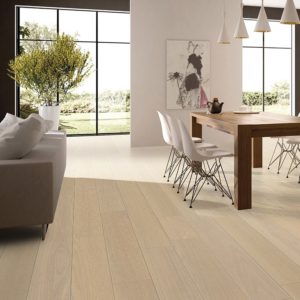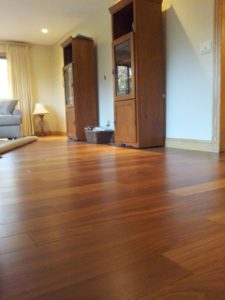
Over the past few years, European oak hardwood floors—especially white oak products—have reigned supreme when it comes to in-demand hardwood species. Retailers, designers and end users attest to not only the natural visual characteristics of the popular species but also the product’s ability to be further enhanced using fuming, surface texturing and innovative reactive staining techniques.
However, it’s important not to overlook the array of imported tropical species available in the market today. These include species like: Peruvian and Brazilian teak as well as Brazilian oak and cherry, to name just a few of the more popular imported species. Many of these products offer their own allure and unique characteristics, especially for those retailers and distributors in the market looking to offer their customers products that serve as point of differentiation—as well as a potential profit center.
“Today, exotics appeal to the high-end of the market, driven by their stories—which is unique, solid color and grain structure, responsible harvesting,” said Dewevai Buchanan, CEO of Nature Flooring. “Interior designers and local retailers that service the high-end are driving the resurgence.”
The common misperception about exotic hardwood—at least those that were first introduced to the U.S. market roughly 15-20 years ago—is that the color palette over time fell out of favor with American consumers enamored with oak and maple. That’s not entirely accurate, experts say. “While we do not think we will ever see the kind of volume produced back in the early 2000s, we are seeing the consumer return to more of the warmer, darker tones that are characteristic of many of our exotic species,” said Jodie Doyle, vice president of sales and marketing, U.S., at Indusparquet. “When you add in the superior durability, performance and truly unique visuals available only in South American hardwoods, those are things today’s consumer can really understand and embrace, and we’re seeing it every day.”
Doyle said it’s important to note there is still a respectable volume of exotic species being sold across the country. “Of the top five SKUs sold by Indusparquet in the U.S. market, three of those are Brazilian cherry,” he explained. “And we are seeing a real movement to other species that are native to Brazil, such as chestnut (Sucupira) and Brazilian oak (Tauari).”
Indusparquet distributor partners attested. “Our customer base still has a significant number of consumers that desire hardwood flooring from Brazil,” said Rick Holden, CEO of Willow Grove, Pa.-based Derr Flooring. “They are looking for that unique color palette combined with the hardness of those exotic species. Indusparquet has evolved their color palette to include more on-trend visuals. The collections include much more than the traditional red tones; beige, gray and mocha tones are now part of most collections.”
Derr Flooring isn’t the only Indusparquet distributor reporting strong interest in exotics. Sean Connolly, regional vice president of sales at Patriot Hardwood—which is owned by Belknap-White Group—is also seeing good sales. “They have the basics—Brazilian cherry, tigerwood, cumaru and Brazilian chestnut, but they also introduced a Brazilian oak—a wide-width solid and engineered line that has some of the top colors that are popular today,” he said. “We’ve done really well with the basic Brazilian cherry products, but we’ve done extremely well with Brazilian oaks in their premier color line.”
Nature Flooring cited particularly strong interest in exotic species such as cumaru and jatoba, especially the solid, 5-inch-wide format. In support of this demand, the company maintains 500,000 hectares of forest in Peru, with three small mills, two drying facilities and a flooring mill. “We estimate exotic market share has remained at 4%-5%, so roughly $150 million at wholesale,” Buchanan said.
Aesthetic allure
From a visual perspective, Brazilian oak might not be that much farther afield from some popular species in the U.S. For example, many say Brazilian oak is reminiscent of North American red oak with its tan to medium tones. These characteristics, experts say, make the leap between popular domestic species and imported exotics a little more manageable. However, on the other end of the spectrum is the species Sucupira (Brazilian chestnut), which varies widely from brownish red to tan hues.

To help bridge the gap between the wide range of colors/visual traits inherent in so many exotic species versus the more mainstream/traditional looks many U.S. consumers demand, suppliers have begun to experiment with different species and processes. For example, the Novo Collection from Indusparquet represents a more modern spin on traditional Brazilian exotics. With Novo, Indusparquet offers low-gloss, textured, handscraped versions of the original wood species. Combined with a wire-brushed surface texture, end users can enjoy a clean, contemporary look—a visual suited for virtually any home or commercial application. “We have challenged our talented design team to step out of their comfort zone and try to produce unique new products and species that are going to turn heads in retail showrooms,” Doyle explained.
It’s not just the visual appeal of exotic hardwood flooring that keeps customers coming back. Exotic hardwood species are also renowned for their extreme durability and stability. Take Brazilian teak flooring, for example. It has a hardness rating of 3540 on the Janka scale, making it one of the most durable species available. “Brazilian teak can endure high-traffic areas and yet provide an elegant look for virtually any residential application,” Nature Flooring’s Buchanan explained. The product is further protected with seven coats of aluminum oxide in the finish layer, he added.
Generally speaking, a Janka rating of 950 is suitable for most standard residential requirements. Common species that offer high dent resistance while being not so hard that they are difficult to mill, process and ultimately nail down include hard maple (a.k.a Canadian maple), white oak, ash, beech and red oak. Many imported species—particularly those from South America—boast even higher Janka ratings. Brazilian ebony, Brazilian walnut and Bolivian cherry, for example, have Janka ratings exceeding 3650 cycles on the Janka scale. Another favorite, Brazilian cherry (Tauri) has a rating of 2350.
“Tauri is harder than white oak and red oak, and it looks like a rift and quarter-sawn product,” Indusparquet’s Doyle noted.

